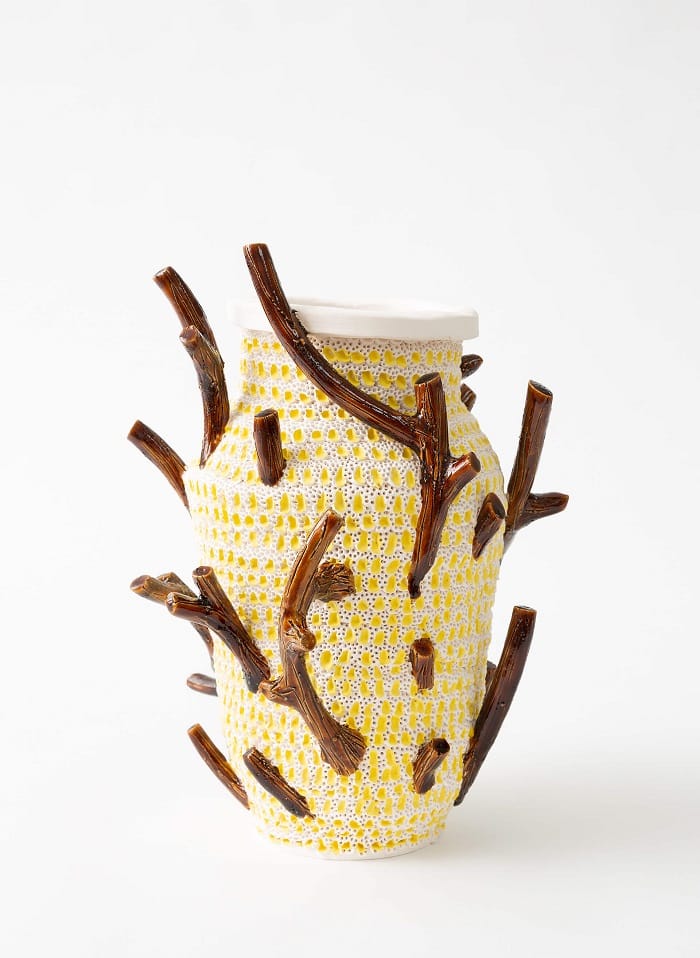
Sullivan+Strumpf have launched the first edition of their newly developed online Viewing Rooms with a digital presentation of the exhibition ‘What do the birds say?’ featuring a new body of work by Australian artist, writer and curator Glenn Barkley.
Gallery Director Ursula Sullivan said, “The viewing room and other aspects of the gallery’s digital engagement has been in development for a little while now, with no real hurry. However, once we were forced into closing our space in Zetland and Singapore, we expedited the whole thing. The digital world seems to be the only way to connect at the moment so we’re making exhibitions more transparent (by giving prices) and also giving our artists a voice through documentary videos and podcasts.”
Barkley is a maker of unique earthenware pots, urns, bottles and objects obsessively dotted with small holes that form intricate crochet-like patterning (or pox as Barkley calls them) on the body of the works embellished with handcrafted motifs and tokens inspired by the artists love of nature, his garden, history and literary works. “History itself has become this sort of compost pile that you can dig through and just re-invigorate over and over,” Barkley muses.
The gallery explains, “The title of the exhibition, ‘What do the birds say?’ is a quote from Kurt Vonnegut’s ‘Slaughterhouse-5’, in which the narrator apologises to his editor for producing a short manuscript. Like birds chirping, the book serves as an unpretentious message demonstrating that life still exists in a devastated world.”
And it was in the midst of the recent bushfires that tore through the NSW South Coast leaving an unprecedented trail of devastation on communities, wildlife and the landscape, that Barkley spent time creating a series of new works. “I have been making this body of work for the last tumultuous six months,” he says.
“I rode out the bush fires over Christmas from the relative safety of Berry, looking from afar while my hometown burnt and the places where I grew up were razed to the ground.”
Throughout the series subtle impressions cast familiar identities on the pox-worked surfaces. The face of Hope is gloriously crowned with ceramic loops in Hope bottle with fancy handles, and a statuette of Her Majesty Queen Victoria is held nobly upright by a cactus in Queen Victoria bottle with handles and branch (2020). The mythical god of the sea, earthquakes and storms emerges in Poseidon with shell stopper and fancy handles (2020), but then Barkley reveals “I say this is Poseidon but it’s just another man with a beard – an ancient figure that a friend gave me that I made a mould from.”

Other more organically-shaped pox pots model what Barkley warmly refers to as ‘prunings’ in various coloured glazes, personal experiences unfold in Pox pot with Fanta prunings (2020), which suggests a full can of Fanta was the possible cause for a child being sick on the bus. Fire urn (2020), a decorated vessel with a lid “has text written by my cousin who survived the bushfires in Australia in January in her town in Conjola when a lot of the other places in her town burnt down,” Barkley records.
“My brother told me of walking on the beach at Cudmirrah, a place that looms large in my dreams and imagination and telling me of all the dead birds on the beach – all the birds, every kind,” the artist shares. “I thought about that as I made these works, as I tried to do something beautiful and contemplative in the face of all that sadness.”
Barkley’s works are beautifully artful and quirky and oscillate between ornamental object and functional vessel. He says, “My work, it has a nod towards function, you could use it for certain things, you probably couldn’t eat off it or drink out of it, you can just stare at it if you want to, which is a form of usage.” And, the longer you look the more you will see.
You are invited to experience Barkley’s show via Sullivan+Strumpfs Viewing Room while listening to the aritst’s curated playlist of songs that will fill your ears with the sounds of Bob Dylan, Clarence Ashley, Neil Young, Bessie Jones, Dave Rawlings Machine and others (available through the gallery website and on Spotify). Barkley’s written texts in the exhibition catalogue playfully characterise each of the 26 works, a short video takes you into Barkley’s studio where he chats a little about his work, and a second upload brings an interview between Barkley and Camilla Wagstaff of Art Collector magazine to the screen.